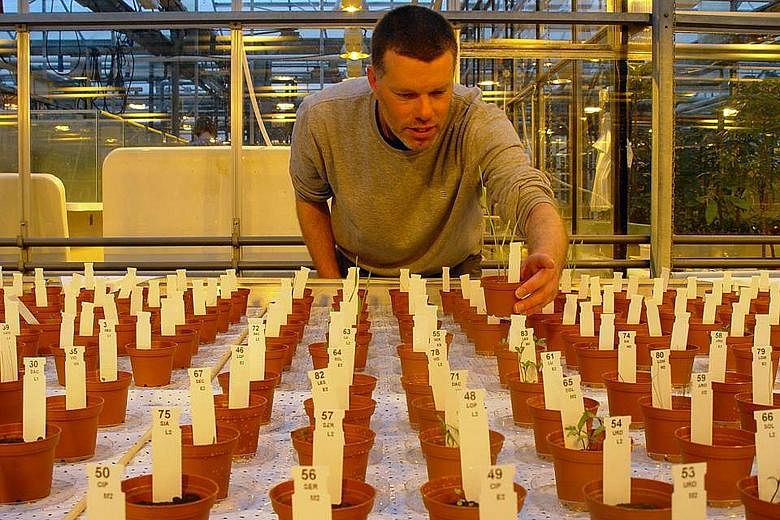If Nasa is working to get humans to land on Mars by 2030, Dr Wieger Wamelink has already made it possible for humans to live there. Well, sort of.
Remember that movie, The Martian, where Matt Damon plays an astronaut left behind on Mars who finds a way to grow potatoes to keep himself alive while Earth sends a rescue mission for him? That's no longer a work of science fiction.
Dr Wamelink, 49, and his team at Wageningen University in the Netherlands have managed to harvest 10 different crops under similar conditions, bringing the idea of establishing a Mars colony one step closer to reality. Last month, they got the scientific community excited when they announced they had successfully grown tomato, rye, spinach, cress, pea, radish, leek, garden rocket, chives and leek.
While the crops took between a month and five months to harvest, getting them to yield has been a four-year-long journey since Dr Wamelink first got stuck on the idea.
In his work as an ecologist, he investigates the occurrence of wild plant species in natural areas based on soil circumstances, such as the acidity and chloride content of the soil, and the quantity of nutrients available.
Having amassed a large database of findings, the Dutch researcher decided to transplant that to Mars and moon soil. He found out that Nasa makes these soil simulants available for research and started his experiment with 14 plants species in 840 pots.
The Mars soil simulant came from a volcano on Hawaii while the moon soil simulant from an Arizonian desert.
The plants grew well on the Mars soil simulant but many of them could not survive on moon soil. Undeterred, he launched a second experiment in 2015, adding organic matter such as grass to the soil.
"We had three major problems in the first experiment: poor growth, water - often two times a day was not enough - and, especially on the moon soil simulant, free aluminium in the solution which is poisonous for plants," he said.
By using trays with two layers, and adding organic matter to the plants, he managed to solve the problems, since organic matter holds water and binds the aluminium.
The crops were picked as they represented a good variety and are important crops for a basic healthy diet, said Dr Wamelink. They were cultivated in a regular greenhouse.
"Both on Mars and the moon, there is almost no air, it's very cold, with dangerous cosmic radiation, so plant growth on the surface is out of the question," said Dr Wamelink, whose own backyard at home is a mini-farm now sprouting with spinach, cabbage and potatoes.
"We assume that plants will be grown indoors and below ground, in a kind of Hobbit home, and light is provided by LED lights and solar panels on the surface."
While this is all good news for aspiring space travellers, the crops cannot be eaten just yet. Making sure they are safe to consume is the third phase of the experiment, which started three weeks ago.
"The main objective is to grow crops in large quantities and test them on food safety. We want to make sure there are no heavy metals in the crops, since we know that lead, arsenic, zinc, iron and mercury are present in the soils," he said.
The crops will also be tested for important nutrients such as vitaminsand flavonoids, while a smaller experiment will look at whether the grown seeds from the previous experiment will germinate. "If they do, then we know we can have several cycles of crops based on one initial badge of seeds," he said.
At least one crop, the cress seeds, has germinated, much to Dr Wamelink's relief.
Worms will also be introduced as they are needed to efficiently break down the organic matter that humans don't eat. "We will look if they can survive in the soils and we will use part of the harvest from last year to feed them." Results from this third phase of the experiment will be out in end-August.
The researchers have been crowdfunding (www.crowdfunding.wageningenur.nl/project/ planten- kweken-op-mars) to keep the experiment going and have raised 40 per cent of the targeted €25,000 (S$38,300).
Dr Wamelink's research will not just benefit future "Martians". The idea is to develop a system where crops can grow under challenging circumstances.
His colleague, Dr Thomas Duck, is working on building a container - a closed system of crop cultivation that could be used in a spaceship or in the the desert or brought to areas where a major disaster has occurred and food supplies have been cut. It will be tested at an Antarctica polar station.
"We could increase the potential area where crops may be grown and thus help to feed the seven billion people on Earth," said Dr Wamelink hopefully.
But farming on Mars is still what excites him the most. "The idea that, at some point in the future, there will be people living on Mars growing their crops and that we were able to be a very small part of that major adventure, maybe the biggest adventure of this century."

